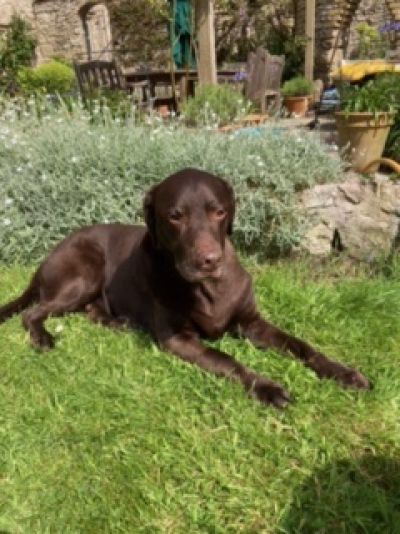
Posted By:
One of the very basic pleasures of having a dog is seeing them enjoy their walks. The daily walk is great on so many levels. It encourages owners to get out and enjoy some exercise and fresh air, it’s vital for your dog’s health and mental wellbeing, and the pure enjoyment your dog gets is just good for the soul – for both the dog and the owner. So when this event starts to be a struggle for dogs it is a clear concern for their owners. This was very much the case for Bailey the 10 ½ year old Labrador.
The lovely Bailey came to see us because his owner had noticed that his walks had become a bit noisy and laboured. When he was settled at home his breathing was fine but as soon as he got a few minutes into his walk, and especially if he was exerting himself, his breathing became rather loud and his energy levels declined.
After a thorough physical examination, Vet Ellen found that Bailey’s heart and lung sounds were all normal and he was in good body condition, but he had increased noise from his upper airway when he breathed in and so Ellen was concerned his symptoms were due to issues in his larynx (voice box).
Breathing issues can occur in the vocal cords as the nerves supplying them begin to decline in function, a condition known as Laryngeal Paralysis. As this happens the vocal cords become flaccid and are unable to open up to allow normal airflow, with patients making a characteristic noise as they breathe in as the floppy vocal cords vibrate. Bailey’s owner was informed that this was a possible diagnosis and that there can be multiple different causes for this condition, so more tests would be required to confirm the diagnosis and establish any concurrent problems which may be contributing to it.
Bailey was admitted a few days later for a full investigation. Firstly, routine blood tests ruled out abnormalities with his blood cells or organ function. Then, Bailey underwent a light general anaesthetic to allow us to directly visualise the movement of his vocal cords. As we could see his vocal cords were completely flaccid we were able to confirm the diagnosis of Laryngeal Paralysis. Finally, we then took xrays while he was anaesthetised to check his chest and ensure there were no other abnormalities that could cause the condition – and the news was good as everything looked normal.
With the diagnosis confirmed, and no other concurrent conditions identified, we were able to discuss the plan with Bailey’s worried owner. Bailey’s condition was obviously affecting his quality of life, and was only likely to deteriorate. Whilst there was no treatment that would restore the nerve function to his larynx we explained that we could still help him. Some lifestyle changes might help them manage his condition, or otherwise there was a surgical option that could open up his airways and improve his breathing. But it wasn’t an easy surgery and, as with any surgery, there can be a number of potential complications to be considered.
Bailey’s owner naturally wanted time to consider everything that had been discussed – whether conservative management would give him the quality of life he needed or whether the difficult and risky surgery was preferable. After a couple of weeks the decision was made – surgery offered the better change for a happy and normal life for Bailey.
The day came for surgery, and whilst everyone was aware of the possible complications, it was also clear when we re-examined Bailey that he required the intervention. Bailey was, as always, very
well-behaved and was the model patient as he was prepared for, and then underwent, his anaesthesia and surgery.
This complex surgical procedure involves operating through the side of the neck to gain access to the larynx. After opening up the muscles of the larynx the individual cartilages that make up the voice box are identified and then sutures are placed between two sections to pull them together. The end result is that one of the vocal cords is placed under tension – like pulling back a curtain – opening up the airway to improve airflow. This sounds routine in theory, but in reality is a delicate procedure where numerous breathing complications can occur.
In fact, Bailey’s surgery went well, but this was only the first stage of his treatment. It was essential that Bailey had a completely calm anaesthetic recovery as any agitation and vocalisation could stress the sutures in his larynx. With this in mind Bailey was recovered in isolation, well away from any other activity, while being constantly monitored. We all breathed a sigh of relief when he was fully recovered and had eaten with no problem, and we made the decision to send him home where he would be calmer and have a relaxed night’s sleep.
The hard work was then down to his owner who followed the post-op plan impeccably. He ensured Bailey was relaxed throughout his recovery but also had to modify the consistency of his diet, a change necessary to avoid the possible complication of food aspiration. However, due to the care he received at home, Bailey improved day-by-day. After a few weeks Bailey was back to enjoying his walks again, with gusto!
Whilst on my visits I have been having several discussions...
As our feline friends get older there are a few conditions...
Another winter discussion group season is now behind...
©2024 Shepton Veterinary Group Ltd., All rights reserved.
Privacy Policy • Terms & Conditions • Cookie Policy